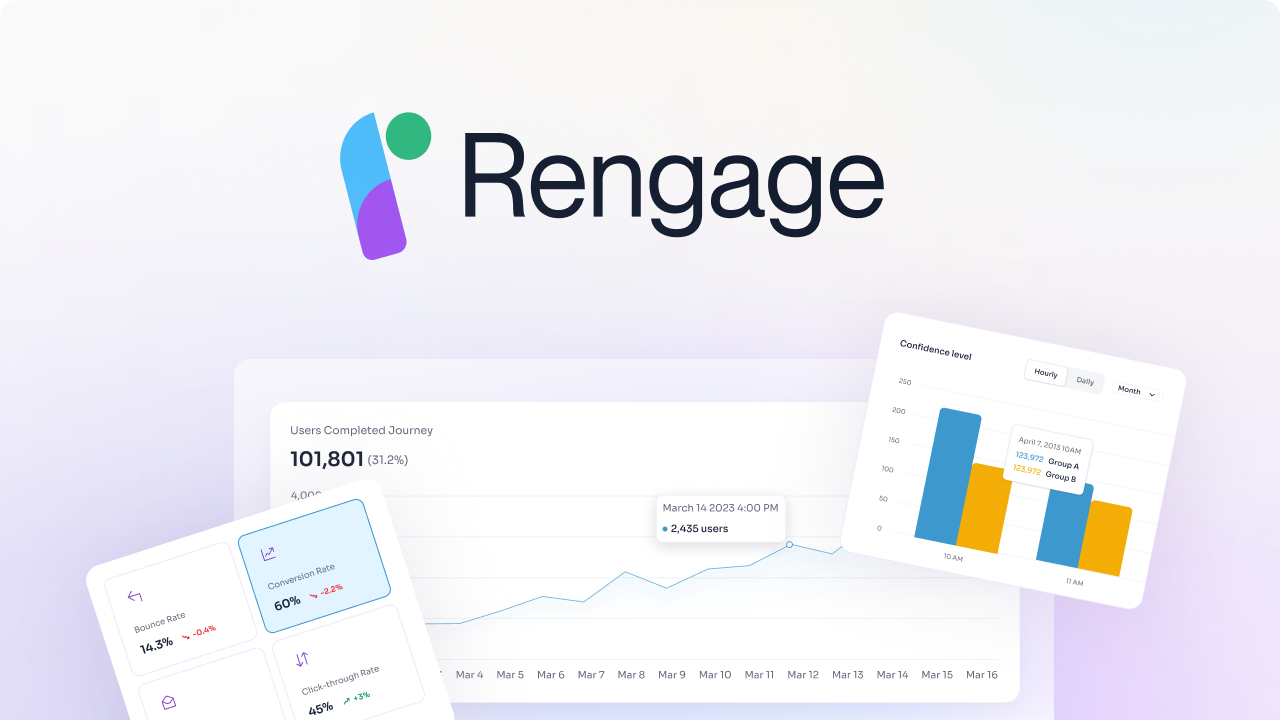Understanding your customers' needs, preferences, and interactions throughout the customer journey is key to successful customer lifecycle management. Comprehensive Customer Journey Research enables businesses to create personalized experiences, improve customer satisfaction, increase loyalty, and boost revenue. This blog will uncover the ins and outs of Customer Journey Research and outline why it is crucial for unlocking business success.
What Is Customer Journey Research?

The significance of customer journey research in enhancing customer experience
Customer journey mapping is a technique that aids companies in understanding the buyer's path to purchase or customer experience. By analyzing touchpoints, a company can improve its customer experience strategies. The goal is to become customer-centric and boost key performance metrics like customer retention.
Answers to common questions about customer journey research
Customer journey research is a blend of qualitative and quantitative methods. These include customer interviews, remote observation, website analytics, and customer satisfaction surveys. By identifying the most impactful touchpoints, companies can optimize the customer experience.
7 Key Components of Customer Journey Research

1. Client Personas
Client personas are detailed profiles of your ideal customers based on real data and research. Creating these personas helps you understand their motivations, pain points, and preferences. By considering demographics, buying habits, goals, and challenges, you can tailor your customer journey map to meet their needs effectively.
2. Touchpoints
Touchpoints refer to interactions between your customers and your brand, such as browsing your website, receiving promotional emails, or speaking with customer service. Identifying and documenting these touchpoints is essential for uncovering insights about the customer journey. To ensure you cover all touchpoints, include both online and offline interactions, as well as indirect ones like reviews or social media comments.
3. Stages
Breaking down the customer journey into distinct stages like awareness, consideration, purchase, and retention enables you to visualize how customers progress through their experience. Understanding these stages helps you locate areas for potential optimization and improvement.
4. Emotions
Recording the emotions customers experience during different stages of their journey helps you empathize with their experiences. By addressing negative emotions and accentuating positive ones, you can enhance the overall customer journey. Techniques like surveys, interviews, and focus groups provide direct insights into customer emotions.
5. Opportunities and Pain Points
Analyzing your customer journey map often reveals challenges and negative experiences that customers encounter. These pain points present opportunities for improvement, which can lead to enhanced customer experiences and satisfaction. By identifying patterns in customer feedback, analyzing support interactions, and observing website/app usage, you can uncover these opportunities.
6. Customer Goals and Expectations
Understanding what customers are looking to achieve and expect from your brand at each stage of their journey is crucial. Incorporating this insight into your customer journey map helps ensure you meet or exceed their expectations, driving satisfaction and loyalty.
7. Channels and Devices
In today's digital landscape, customers interact with brands across various channels and devices. Understanding which channels and devices customers utilize during different stages of their journey can help you optimize their experiences across all touchpoints effectively.
Exploring the Power of Personalized Customer Experiences with Rengage
Book a free demo to learn about how you can transform customer interactions into personalized experiences that drive loyalty and growth.
Related Reading
• Customer Lifecycle Management Best Practices • Customer Journey Analytics • Customer Journey Stages
7 Benefits of Conducting Customer Journey Research

1. Improved Approach to Customer Support and Service
One of the benefits of customer journey mapping is giving companies the chance to analyze the customer’s thought process while communicating with them. Taking into consideration their emotions at the time, along with the actions they’re taking. By doing this, businesses can then formulate an improved way to approach customer support and service.
2. More Effective Marketing Strategies through Learned Customer Behavior
Customer journey mapping brings to light the customer’s needs and pain points. Because they are brought into sharper focus, you are then capable of formulating a marketing plan that hits all the right spots. Another one of the benefits of customer journey mapping is that you can position your products and/or services to answer the customer’s requirements.
3. Targeted Marketing Leads to Audience Growth and Increased Engagement
Thanks to the benefits of customer journey mapping, your company will be able to make realistic changes to your website and business social media accounts. This will drum up more interest in your business from customers and investors alike. The changes that make your business more accessible, showing that your brand is more than capable of meeting customers’ needs will encourage visitors to engage with you more and more.
4. Higher Conversion Rates, Faster Sales Cycles, and Bigger Revenue
When you know your customers, everything happens at a quicker pace. Since your marketing content is a lot more focused, your sales efforts will get more rewarded. It becomes a less strenuous part of the cycle, and you will find the task of relating to customers and closing a sale more enjoyable. You won’t even need a lot of persuading.
5. Omnichannel Marketing and Support Based on Customer Research
Like it or not, people have preferences even when it comes to the communication channels that they always use. For some, phone calls get the job done a lot faster. For others, it’s not fast enough, and live chat is a better fit. Some prefer sending emails, and so on. For a business that wants to cater to a wide spectrum of customers whenever needed, you should always be ready to do so.
6. Enhanced Communication and Understanding through Customer Feedback
Insight is one of the valuable benefits of customer journey mapping. When you get your facts and qualitative data straight from the customer, you have a bigger chance of having them continue on their journey with your company or convert to a sale. Seek to clarify which areas in your website confuse them, for example.
7. Better Overall Team Collaboration
Since you’ve eliminated the blockades among the teams in your company and given them all the directives to achieve one common goal, you can expect better collaboration. This is not only within your customer service team or sales. But this also covers how a [team cross-functions]9https://www.bigcommerce.com/glossary/cross-functional-collaboration/) with another to work seamlessly as one. Because you’re able to clearly define each one’s job to enhance the customer journey, there will be no room for miscommunication or misunderstanding.
8 Key Metrics to Track When Conducting Customer Journey Research

1. Impressions
Digital marketing and advertising can simplify how organizations track the number of times people have viewed a website, landing page, or social media post. Along a digital customer journey, CX teams can better track metadata containing information about each prospective customer. This analysis allows CX teams to identify interest and fine-tune messaging to attract the largest audience possible.
2. Click-Through Rate
While views and impressions are great, the next metric CX teams should closely follow is the click-through rate (CTR). The CTR is the ratio of the number of views a marketing campaign or advertisement has versus the number of people that actually click on a link to purchase a product or learn more about it.
3. Engagement Rate
Understanding the health and popularity of a product or brand can reveal a great deal about whether an organization has properly marketed a product toward customers. Customer engagement rates track both positive and negative interactions between customers and the brand. CX teams can analyze these interactions to determine customers' levels of interest in a product or brand, and to identify and potentially remediate any negative experiences.
4. Cost per Lead
Marketing and advertising can cost a lot or a little depending on the methods used. The goal of these campaigns is to generate leads, which are customers these teams have identified as showing interest in a product or service. CX teams can use these tools to validate whether a particular campaign led to leads that either would or would not justify the cost of similar campaigns in the future.
5. Cost per Conversion
While leads are great, the overall goal is to convert them into paying customers. CX teams must calculate the cost per conversion rate, which tracks the cost of a campaign divided by the number of people or businesses that ultimately opt to purchase a product or service. This information can help marketing and sales teams identify if they're simply making noise or helping successfully close a deal.
6. Customer Satisfaction
Positive experiences help guarantee repeat transactions, increase the overall customer lifetime value, and create a loyal base that can help an organization promote its products or services and gain new referrals at a low cost. An important part of customer journey KPI analysis is direct and indirect feedback about customers' opinions on what they purchased and improvements the organization can make in post-sales service experiences.
7. Customer Churn Rate
Understanding why a customer stops using a product or service can be as valuable as monitoring how the organization gains new customers. CX teams can adjust their processes along the customer journey to lower the churn rate and identify why customers leave.
8. Customer Lifetime Value
CX teams should closely track the customer lifetime value of repeat purchasers to ensure the cost of long-term retention does not exceed the monetary value they deliver. Monitoring customer lifetime values is crucial to ensure this ratio does not get out of balance.
Related Reading
- Digital Customer Journey Mapping
- Customer Journey Analysis
- Ecommerce Customer Journey
- B2B Customer Journey
- Customer Journey Orchestration
- Omnichannel Customer Journey
- Saas Customer Journey
- Marketing Automation Customer Journey
- Customer Journey Optimization
- Micro Moments Customer Journey
- Customer Journey Automation
- Customer Journey Insights
- Customer Journey Dashboard
- Customer Journey Personalization
- Customer Journey Metrics
- Customer Journey Best Practices
10 Best Tools for Customer Journey Research
Website and behavior analytics tools are vital for understanding customer behavior and optimizing their journey on your website. Traditional website analytics software offers quantitative data, such as traffic metrics and demographic information like bounce rates and goal conversion rates.
Behavior analytics tools, on the other hand, provide qualitative insights into how users interact with your website. This includes understanding where users spend time, which buttons they click, and where they exit the funnel. These tools help pinpoint usability issues and enhance the overall user experience.
1. Rengage

Rengage offers a comprehensive solution for managing and enhancing customer journeys without the need for coding. It accelerates the customer journey from onboarding to conversion by providing insights and measurable outcomes. With features like Journey Moments and Journey Builder, Rengage allows you to gain insights into segments, run campaigns, and measure the impact of your journeys on user conversion.
By booking a free demo, you can learn how to turn customer interactions into personalized experiences that drive loyalty and growth.
2. Hotjar
Hotjar is a powerful tool for understanding customer behavior through Funnels, Heatmaps, Recordings, Surveys, and a Feedback widget. Funnels illustrate the path of the customer journey, while Heatmaps and Recordings reveal user behavior, including clicks, scrolls, and actions. Hotjar's automation and collaboration features, like AI for Surveys and Highlights, streamline insight sharing.
3. Google Analytics 4
Google Analytics 4 is a web analytics tool that tracks website traffic metrics like bounce rates, goal conversions, and user demographics. It provides data on traffic sources, popular landing pages, and exit points. With this tool, you can gain insights into where your website traffic originates and which channels drive conversions.
4. Heap
Heap is a no-code product analytics tool that tracks customer data and product usage throughout the customer journey. It helps identify pain points, improve retention, and reduce churn by offering insights into customer segments and their behaviors.
5. Clarabridge
Clarabridge is an AI-powered feedback text analytics tool that analyzes customer sentiment about your brand across various sources. It provides insights into user sentiment, helping you understand how people perceive your brand and business.
6. InMoment
InMoment is an experience-intelligence tool powered by AI that offers detailed feedback from users. It prompts users for further details on their experience, enabling you to gather meaningful feedback and monitor social sentiment.
7. Miro
Miro is an online whiteboard workspace ideal for remote teams. It allows teams to brainstorm and share ideas on a digital whiteboard. Whether creating boards from scratch or using templates, Miro is a versatile tool for digital collaboration.
8. UXPressia
UXPressia focuses on creating customer journey maps with an intuitive interface and customizable templates. This tool is perfect for visualizing customer touchpoints and enabling real-time collaboration across different departments.
9. Smaply
Smaply is a mapping tool designed for complex customer journeys, providing insights into channel usage and backend processes. It allows users to create a repository of customer insights and integrates with project management tools for streamlined collaboration.
10. Gliffy
Gliffy is a collaborative diagram tool that simplifies the creation of large diagrams. With drag-and-drop functionality and Google Drive integration, Gliffy is perfect for mapping out ideas and tracking changes in real time.
7 Effective Customer Journey Research Methods

1. Customer Interviews
Customer interviews are one-on-one conversations with people who actually use your product or service. Conducting them in-person often yields the best results because it’s easier to pick up on non-verbal cues and the interview can flow more naturally—but video conferencing with tools like Zoom is a good secondary option.
2. Remote Observation
Remote observation lets researchers see how users are behaving using online tools like video calling and screen recordings. Remote research is convenient for both researchers and participants—neither party has to leave the comfort of their home or workspace and they can do what they need to do when it suits their schedule.
3. Lab Observation
In lab observation, the researcher observes the participant in person, either in a formal ‘lab’ setting or another professional, controlled environment. Lab observation can be complicated to carry out because of the cost and logistics involved, and it’s often more time-consuming than remote methods.
4. Qualitative Surveys
Qualitative surveys usually involve asking open-ended questions that prompt detailed, long-form user responses. They give you great customer insights to inform your journey map, are easy to put together, inexpensive, and work well with large numbers of participants.
5. Website Analytics
Because website analytics show you hard data about how people are interacting with your site, they’re a great resource for customer journey mapping research. Investigate these key metrics to better understand how your users move across touchpoints.
6. Quantitative Surveys
Quantitative surveys ask customers closed-ended questions that can be answered quickly—by checking yes or no, typing in one word, or selecting a multiple-choice answer. Quantitative surveys can take a bit longer to put together, but they’re quick and easy for customers to fill out.
7. Customer Satisfaction Scores
Measuring customer satisfaction is important to understand which touchpoints are working well for your users, and which you need to improve. In particular, Net Promoter Score® (NPS) is a great indicator of overall customer loyalty and satisfaction.
Related Reading
- Customer Lifecycle Management Software
- Customer Journey Mapping Tools
- Customer Journey Management
- Braze Alternative
- Fullstory Alternatives
- Adobe Analytics Alternatives
- Customer Journey Analytics Tools
- Iterable Competitors
- Marketo Alternatives
- Onesignal Alternatives
- Clevertap Alternatives
- Bloomreach Alternatives
- Customer.io Alternatives
What Are the Best Practices for Conducting Customer Journey Research?

Ethical Guidelines
To ensure that customer journey research is conducted responsibly, it is essential to follow ethical guidelines. This involves obtaining consent from customers before collecting their data, ensuring their anonymity, and handling their data securely.
Templatize Everything
To conduct efficient and effective research, it is crucial to templatize everything. From survey questionnaires to form structures, having templates in place can streamline the research process and make it easier to gather data on the go without wasting time.
Use a Mix of Research Methods
Customer journey research isn't one size fits all. It requires a combination of research methods to gather the most relevant and useful data. Incorporating both statistical insights and contextual data will provide a comprehensive view of the customer journey.
Involve Cross-Functional Teams
Collaboration among various teams such as marketing, sales, and customer service is essential in customer journey research. Bringing diverse perspectives and skills to the table helps ensure a more holistic understanding of the customer journey and enhances the quality of the research.
Continuous Feedback and Updates
Customer journey research is an ongoing process that requires continuous feedback from stakeholders and customers. By seeking feedback and incorporating new insights and data, the customer journey maps can be continuously updated and refined to stay relevant and effective over time.
Create Personalized Experiences That Drive Loyalty and Growth with Rengage — Book A Free Demo Today
Rengage provides a comprehensive solution for managing and enhancing customer journeys, delivering insights and measurable outcomes with no code. It accelerates your customer journey from onboarding, activation to conversion, and churn. With Rengage, you can get insights into your segments, run campaigns with an intuitive journey manager, and measure how your journeys impact user conversion through Journey Moments and Journey Builder features.
Harnessing Micro-Segment Insights
Journey Moments provides insights into your micro-segments, allowing you to understand the behavior and preferences of specific customer groups. This information is crucial for creating personalized marketing strategies and campaigns that resonate with these segments, leading to higher conversion rates and increased customer loyalty.
Crafting Personalized Customer Journeys
Journey Builder is an intuitive multi-channel marketing automation tool that allows you to create and automate personalized customer journeys. By leveraging this feature, you can design and deliver targeted messages through various channels, such as email, SMS, and push notifications. This ensures that your customers receive the right message, at the right time, through the right channel, maximizing engagement and conversion rates.
Leveraging Insights Prediction and Attribution
Insights Prediction and Attribution is a key feature of Rengage that provides you with valuable data on the performance of your customer journeys. By analyzing this data, you can gain a deeper understanding of your customer's behavior, predict their future actions, and attribute conversions to specific touchpoints in the customer journey. This insight is invaluable for optimizing your marketing strategies, improving customer engagement, and driving business growth.
Unlocking Revenue with Personalized Experiences in Rengage
Rengage offers a powerful suite of tools and features that enable you to transform customer interactions into personalized experiences that drive loyalty and growth. Book a free demo today to learn more about how Rengage can help you unlock revenue from your existing user base and achieve your marketing goals.
